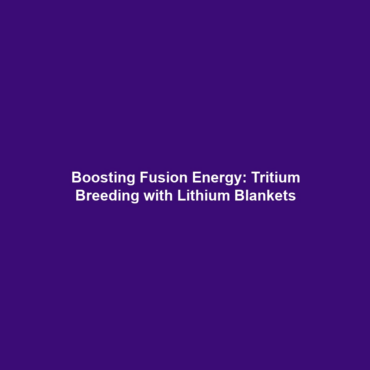Tritium Breeding in Fusion Energy
Introduction
Tritium breeding is a crucial aspect of future fusion reactors that may utilize lithium blankets to effectively capture neutrons emitted during fusion reactions. This process not only generates tritium, a vital fuel for sustaining the fusion reaction cycle, but also symbolizes a significant advancement towards the realization of practical fusion energy. Understanding the principles of tritium breeding highlights its importance in the quest for clean, renewable, and sustainable energy sources capable of addressing global energy demands.
Key Concepts
In the realm of Fusion Energy, tritium breeding involves several fundamental concepts that enhance the feasibility of fusion reactors:
- Fusion Reactions: The process where light atomic nuclei combine to form heavier nuclei, releasing immense energy.
- Neutron Capture: A technique where lithium in blankets absorbs high-energy neutrons produced in fusion, leading to the generation of tritium.
- Tritium Production: Tritium is a radioactive isotope of hydrogen essential for sustaining the fusion reaction process.
- Reactor Design: Future fusion reactors will incorporate lithium blankets strategically designed for efficient neutron capture and tritium breeding.
Applications and Real-World Uses
The applications of tritium breeding are pivotal in advancing Fusion Energy. Here are some notable examples:
- Power Generation: Tritium breeding is integral to the operation of fusion reactors aimed at producing electricity sustainably.
- Hydrogen Production: The process contributes to hydrogen generation, vital for fuel cells and clean energy solutions.
- Medical Uses: Tritium finds applications in certain medical imaging technologies.
Tritium breeding enhances the sustainability and viability of fusion energy as a clean power source, demonstrating how it is utilized in various sectors.
Current Challenges
Although tritium breeding presents promising advancements in Fusion Energy, several challenges persist:
- Efficiency of Breeding: Achieving optimal breeding ratios is essential and currently a challenge in reactor design.
- Material Durability: The materials used for lithium blankets must withstand the harsh conditions within fusion reactors.
- Regulatory Issues: Navigating the regulatory landscape for radioactive materials such as tritium poses significant hurdles.
- Cost of Development: The high expense involved in developing and constructing fusion reactors with tritium breeding capabilities can be a barrier to progress.
Future Research and Innovations
Ongoing research in tritium breeding is focusing on innovations that could revolutionize Fusion Energy:
- Advanced Materials: Researchers are developing new materials that improve neutron capture and withstand extreme reactor conditions.
- Improved Reactor Designs: Innovations in reactor configurations can enhance tritium breeding efficiency.
- Automation and Control Technologies: Enhancements in operational control systems may lead to safer and more efficient fusion reactions.
These innovations are instrumental in paving the way for next-generation fusion reactors.
Conclusion
In summary, tritium breeding using lithium blankets is a vital component in the development of sustainable Fusion Energy reactors. By addressing current challenges and fostering future research, the potential for harnessing fusion power becomes increasingly viable. As we move forward, it is essential to continue exploring these advancements to secure a clean and sustainable energy future.
For further reading on Fusion Energy and advancements in tritium breeding, visit our related articles page.

Leave a Reply